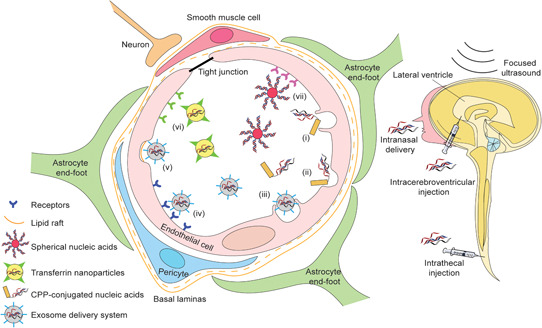Figure 4.

Strategies for the delivery of nucleic acid drugs across the blood–brain barrier into the central nervous system. The blood–brain barrier is formed by the cerebral endothelial cells with tight junctions at their margins, pericytes, basal lamina, and astrocytic end‐feet. Intracerebroventricular and intrathecal injection or infusion can directly administer compounds, including nucleic acids, into the central nervous system. Through intranasal administration, nucleic acid drugs can enter the central nervous system through the nose‐to‐brain route, mainly mediated by the olfactory and trigeminal nerve pathways. 250 Cell‐penetrating peptide‐conjugated nucleic acids are taken up through macropinocytosis (i) and endocytosis (ii) by the endothelial cells. The exosome system delivers nucleic acids across the blood–brain barrier mainly through receptor‐mediated endocytosis (iv), lipid‐raft mediated endocytosis (v), and macropinocytosis (iii). Receptor‐mediated endocytosis also contributes to the uptake of transferrin nanoparticles (vi) and spherical nucleic acids (vii) [Color figure can be viewed at wileyonlinelibrary.com]
